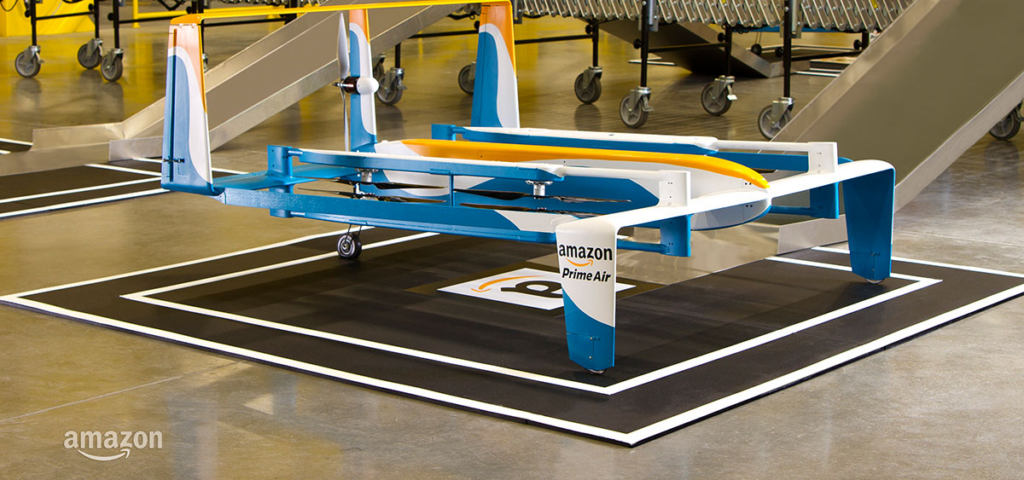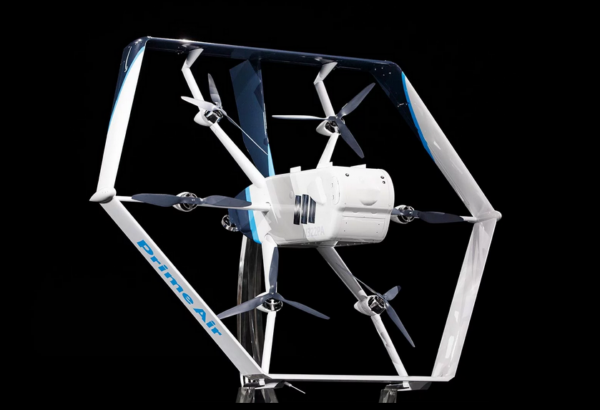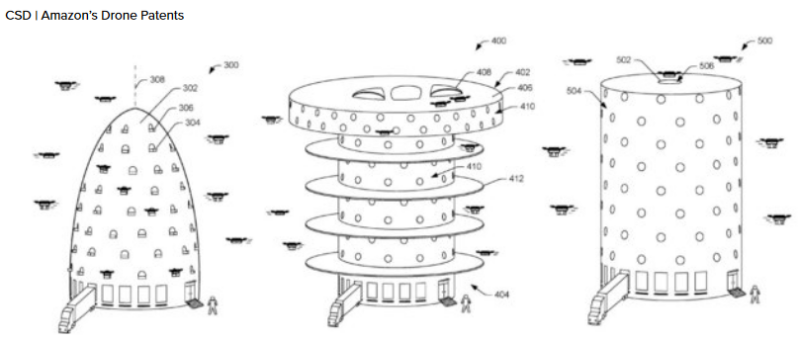
It looks like science fiction, but it’s real: Amazon Prime Air is a delivery system from Amazon that delivers parcels by drone. The small drones can transport a delivery weighing up to 2.5 kg, which covers the majority of Amazon’s parcels. They fly at speeds of up to 80 km/h at an altitude of 122 meters and are automated with GPS from the warehouse to the recipient. The range of the drones is around 25 km, which should enable delivery in densely populated cities in particular. The drone itself weighs 25 kg.
The drone finds the right house, for example, by the recipient placing a printed QR code clearly visible in the garden and marking it as the landing area. If the drone has difficulty landing, the recipients are automatically called to allow it to land. If no one is at home and delivery is therefore not possible, the drone flies back to the warehouse.
The development of Amazon Prime Air
The development of Amazon Prime Air began back in 2014 and was personally initiated by Jeff Bezos. Development centers are located in the United States, the United Kingdom, Austria, France and Israel. On December 7, 2016, a parcel was successfully delivered by drone to a customer in Cambridgeshire, England, for the first time. He lived near the logistics center. It took just 13 minutes from order entry on the internet to completion of the delivery. Prime Air is also working on an environmentally friendly system that will improve the existing service for millions of customers.
Prime Air was originally due to be launched in the USA in 2018. However, this was not possible for a long time due to the strict requirements of the US aviation authorities. A new, improved drone was presented at the Mars Conference in Las Vegas in 2019. This drone offered more stability, efficiency and safety than the previous model, for example by breaking apart in the event of an accident instead of falling to the ground as a whole. This reduces the risk of injury to people in the vicinity of the crash. A drone also has a camera, thermal imaging technology and ultrasound. This allows the drones to detect and avoid obstacles such as other aircraft, people, animals, chimneys and cables. After tough negotiations, the US aviation authority granted Amazon approval for Prime Air in August 2020.
Prime Air is due to be launched in the USA in 2022.Automated drone deliveries are to be carried out as a pilot project in Lockeford, California.The residents of Lockeford will be asked to provide feedback on the drones in order to further improve the service.However, users will initially only be able to order selected products.

In what weather is delivery by Amazon Prime Air possible?
Currently, deliveries with Amazon Prime Air can be carried out during the day and when there is little wind. Visibility must also be perfect and it should not be raining, snowing or hailing. As soon as initial experience has been gained to improve safety and reliability, work will continue on the further expansion of Amazon Prime Air.
The goal: to deliver an Amazon Prime Air delivery to customers in less than 30 minutes, anywhere in the world.
More ideas from Amazon
In its patent, Amazon envisages several prototypes of what a department store could look like in the future. Similar to a honeycomb, these have several landing stations into which the drones can fly in and out. Rooms for flight controllers could be set up in the upper part of the department stores to monitor the drone flights and intervene in the event of a problem.

Amazon also has the idea of converting lampposts so that the drones can land on them to recharge themselves independently in the event of battery problems. At the same time, these poles could also be converted into parcel stations where parcels can be dropped off or picked up.
The advantages of Prime Air
Parcel delivery with Amazon Prime Air is associated with numerous advantages:
- Fast deliveries: Prime Air makes it possible to deliver parcels within 30 minutes, which is a revolution in the e-commerce sector. Logistics processes are faster, more efficient and therefore more cost-effective.
- A positive environmental aspect: the drones have very low energy consumption, which also means fewer emissions. In addition, fewer delivery vehicles on the roads also protects the environment.
- Low workload: As the drones fly autonomously, this in turn means less manpower is required to deliver the orders.
- Low unit price of the drones: Mass production of drones would have a low unit price, which would save Amazon money.
- Amazon’s USP: With the patents for Prime Air and the functioning, fast delivery of goods, Amazon stands out strongly from its competitors and offers another unique selling point compared to other online retailers.
Disadvantages of Prime Air
There are some issues that pose a risk in connection with drone deliveries:
- Drone safety: Even though drone technology is advanced, there is still a potential risk from possible collisions or crashes.
- Warehouses: Warehouses are normally located outside cities due to their size. However, as the drones can only fly 25 km, new warehouses would have to be built in the cities.
- Public skepticism: There are probably many people who do not necessarily welcome seeing or hearing drones over their gardens and homes. Private individuals could take legal action against the Prime Air service.
- Official approvals: The example of the USA has already shown that it can take several years to obtain the necessary approvals from all authorities. Such delays result in high financial losses for Amazon.
- Job losses: Another impact of increasing drone traffic could be a sharp reduction in staff, particularly in logistics centers. If Prime Air establishes itself as a delivery service, other parcel delivery companies could also be threatened by this supremacy.